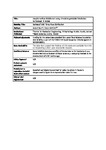Hospital surface disinfection using ultraviolet germicidal irradiation technology: A review
| dc.contributor.author | Scott, R | |
| dc.contributor.author | joshi, lovleen | |
| dc.contributor.author | McGinn, C | |
| dc.date.accessioned | 2022-05-07T14:00:37Z | |
| dc.date.issued | 2022-05-28 | |
| dc.identifier.issn | 2053-3713 | |
| dc.identifier.issn | 2053-3713 | |
| dc.identifier.uri | http://hdl.handle.net/10026.1/19204 | |
| dc.description.abstract |
Ultraviolet germicidal irradiation (UVGI) technologies have emerged as a promising alternative to biocides as a means of surface disinfection in hospitals and other healthcare settings. This paper reviews the methods used by researchers and clinicians in deploying and evaluating the efficacy of UVGI technology. The type of UVGI technology used, the clinical setting where the device was deployed, and the methods of environmental testing that the researchers followed are investigated. The findings suggest that clinical UVGI deployments have been growing steadily since 2010 and have increased dramatically since the start of the COVID-19 pandemic. Hardware platforms and operating procedures vary considerably between studies. Most studies measure efficacy of the technology based on the objective measurement of bacterial bioburden reduction; however, studies conducted over longer durations have examined the impact of UVGI on the reduction of healthcare associated infections (HCAIs). Future trends include increased automation and the use of UVGI technologies that are safer for use around people. Although existing evidence seems to support the efficacy of UVGI as a tool capable of reducing HCAIs, more research is needed to measure the magnitude of these effects and to establish recommended best practices. | |
| dc.format.extent | 25-33 | |
| dc.format.medium | Electronic-eCollection | |
| dc.language | en | |
| dc.language.iso | en | |
| dc.publisher | Institution of Engineering and Technology (IET) | |
| dc.subject | Bioengineering | |
| dc.title | Hospital surface disinfection using ultraviolet germicidal irradiation technology: A review | |
| dc.type | journal-article | |
| dc.type | Journal Article | |
| dc.type | Review | |
| plymouth.author-url | https://www.ncbi.nlm.nih.gov/pubmed/35662749 | |
| plymouth.issue | 3 | |
| plymouth.volume | 9 | |
| plymouth.publication-status | Published | |
| plymouth.journal | Healthcare Technology Letters | |
| dc.identifier.doi | 10.1049/htl2.12032 | |
| plymouth.organisational-group | /Plymouth | |
| plymouth.organisational-group | /Plymouth/Faculty of Health | |
| plymouth.organisational-group | /Plymouth/Faculty of Health/School of Biomedical Sciences | |
| plymouth.organisational-group | /Plymouth/REF 2021 Researchers by UoA | |
| plymouth.organisational-group | /Plymouth/REF 2021 Researchers by UoA/UoA01 Clinical Medicine | |
| plymouth.organisational-group | /Plymouth/Users by role | |
| plymouth.organisational-group | /Plymouth/Users by role/Academics | |
| dc.publisher.place | England | |
| dcterms.dateAccepted | 2022-05-05 | |
| dc.rights.embargodate | 2022-6-2 | |
| dc.identifier.eissn | 2053-3713 | |
| dc.rights.embargoperiod | Not known | |
| rioxxterms.versionofrecord | 10.1049/htl2.12032 | |
| rioxxterms.licenseref.uri | http://www.rioxx.net/licenses/all-rights-reserved | |
| rioxxterms.type | Journal Article/Review |


